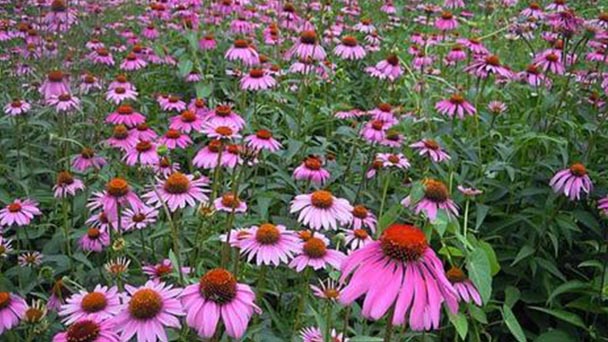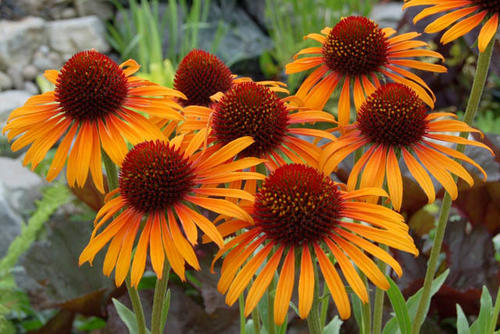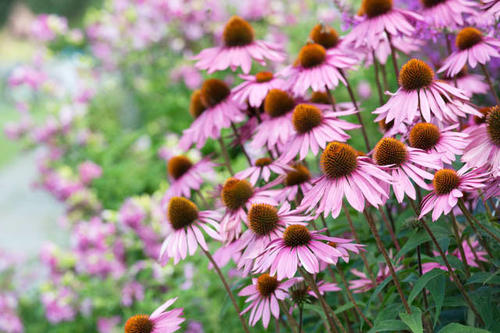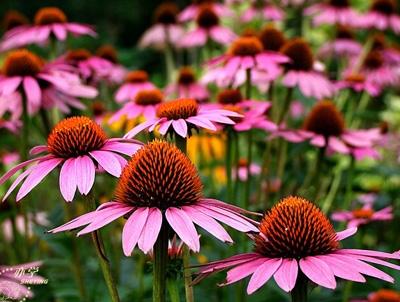Purple coneflower (Echinacea purpurea) profile
Written by Maggie
Apr 07 2021

Purple coneflower (Echinacea purpurea) is a perennial herb of the genus Purple Coneflower. Purple coneflower is a wildflower in the Compositae family. It is named because its head resembles a pine cone. Its shape is somewhat similar to ordinary chrysanthemum, with larger flowers, bright colors, beautiful appearance and high ornamental value. Purple coneflower is one of the indispensable flower varieties for gardens, parks, street green space and street greening and beautification, and festival flower arrangement. It has been planted all over the country. Purple Coneflower also has a very high medicinal value, is currently mainly used in the treatment of cold, cough, upper respiratory tract infections and other diseases, and herbal medicine.
Purple Coneflower is native to central and eastern North America. Some species are currently under protection. There are many cultivations around the world, sowing and breeding more than spring, autumn, robust growth, easy management.
Purple coneflower picture

Purple coneflower info
| Botanical Name | Echinacea purpurea |
| Common Names | Purple coneflower |
| Plant Type | Herbaceous perennial |
| Sun | Full sun, partial shade |
| Hardiness Zones | 3 to 8 (USDA) |
| Flower color | Purple, pink |
| Native Area | North America |
| Mature size | 2–5 ft. tall, 1–2 ft. wide |
The morphology of purple coneflower
Purple Coneflower is a perennial herb, 50 -- 150cm tall, with thick hairs and erect stems. Basal leaves are ovate or triangular, cauline leaves ovate-lanceolate, petiole base slightly clasped; Capitate is solitary on branch apex, or a few aggregates, flower diameter up to 10cm, lingulate purple-red flowers, tubular orange-yellow flowers.
Purple Coneflower is 60 -- 120 cm tall with tall stems, solitary flower heads, large flowers with corolla diameters of 8 -- 13 cm. The flowers are strangely shaped, spherical in the center of the plant. The tubules are orange and yellow, surrounded by ligulate petals, red, pink, polychromed, and white. After artificial cultivation, it can blossom in May and October each year, and the flowering period lasts 1-2 months. Purple Coneflower seeds mature in autumn. Seeds are hard and light brown.
Habits of purple coneflower
Purple Coneflower likes warm, strong and hardy. Purple coneflower is resistant to drought. Do not choose the soil, in the deep fertile humus-rich soil on the growth of good, big flowers, colorful.
How to grow and care for purple coneflower
Light
To get the most blooms (and the sturdiest plants), plant your pink coneflowers in a spot that receives at least six to eight hours of full daylight every day. The vegetation will tolerate partial shade, however may additionally in the end flop over, and the blooms might not be as prolific.
Soil
Coneflowers develop first-class in a backyard that boasts an impartial soil pH of about 6.5 to 7.0. They can thrive in a range of soil types, which includes sandy, rocky, and clay soils. However, they do no longer like moist or mucky soil. For satisfactory results, add a bit of compost to your combination when planting to supply your coneflowers a suitable start.
Water
Coneflowers are frequently listed as drought-tolerant plants, however they will simply do a good deal higher with pretty everyday watering. Water them each day simply after planting, then transition to an inch of water per week for the relaxation of the plant's first 12 months of life. Second-year and older flora may also solely want watering at some point of droughts.
Temperature and humidity
As a native prairie plant, pink coneflower prospers in hot, dry climates however can cope with a variety of temperature and humidity fluctuations. However, they do not now do as properly in very humid climates, or in wet areas where the soil stays wet.
Fertilizer
Although coneflowers thrive fine in a soil excessive in natural matter, too plenty supplemental fertilizer can cause them to emerge as leggy. Adding compost every spring commonly offers them the diet they want for healthful foliage and blooms.
Pruning
Pruning pink coneflower is helpful, however no longer imperative. You can go away from the flora standing for the duration of the iciness months to feed the birds, and shearing them again in the spring will result in bushier plant life that blooms longer into the season.
That being said, deadheading is the most important preservation for coneflowers. They are prolific bloomers, and deadheading (removing the lifeless plant life from dwelling plants) will preserve them in bloom all summer.
Flowers begin blooming from the pinnacle of the stem, and every flower stays in bloom for various weeks. As the preliminary flower fades, greater aspect shoots and buds will structure along the stem. Keep the flora deadheaded, and you may maintain getting extra flowers. The procedure will additionally assist stop an overabundance of self-seeding from the plant.

How to grow purple coneflower from seed
Purple coneflowers are fairly handy to develop from seed. If you would like to retailer the seed, wait till the cone has thoroughly dried—it has to be darker in coloration and stiff to the touch. The seeds are connected to the sharp spines, so you may desire to put on gloves, and separate the seeds from the cone. Spread them on a paper plate or display screen to dry entirely earlier than storing.
The seeds germinate satisfactory with some bloodless stratification. The best approach is to sow them outside in the fall, both in the floor or wintry weather sowing them in milk jugs. If you are going to begin seed indoors, simulate the chilling duration by using planting seeds in a damp seed beginning combination and putting the sealed container in the fridge for eight to 10 weeks. Then, take them out and plant them as you commonly would. The seeds need darkness to germinate, so plant them about half of an inch deep and cowl them with soil. They have to germinate inside 10 to 14 days. Place the seeds beneath develop lights that are about an inch or two above the plant as soon as the seedlings emerge.
The propagation of purple coneflower
Purple coneflower propagation: sowing method of propagation, in spring and autumn, healthy growth, easy management.
Purple coneflower is mainly sowing propagation, sowing propagation and cutting propagation, mainly sowing propagation. The sowing and breeding: sowing can be carried out in late April in spring or early September in autumn, will be exposed to the deep seed-bed leveling: pouring permeable, to be all the water into the ground after sowing seeds, keep each seed covers an area of 4 square centimeters, control the temperature at about 22°C, 2 weeks can germinate. Transplant seedlings when seedlings grow to 2 true leaves. Plant when the seedlings are about 10 cm tall. Plant row spacing 40×40 cm. (2) Substrate propagation: for perennial female plants, substrate propagation can be done in spring and autumn. Each Purple coneflower needs 4-5 terminal buds to be cut away from the rhizome. (3) Cutting propagation: take about 5 cm long tender shoots, even inserted into the sand bed, the requirements of the slotting can not be too wet, and the air humidity should be high, at the temperature of 22°C conditions for 3-4 weeks to root.
Seed propagation
Sowing can be carried out in spring or early autumn. After the open seedling bed is turned over and leveled, the water is poured and the seeds are removed after all the water penetrates into the underground. Each seed covers an area of 4cm2, and the temperature is controlled at about 22℃, and germination can be achieved in 2 weeks. Seedling growth jumped to 2 true leaves time seedling transplantation. Transplant when the seedling height is about LOCM. Plant row spacing was 40cm×40cm.
Division propagation
The perennial mother plant can be in the spring and autumn season division propagation. Each Purple coneflower needs 4 ~ 5 terminal buds to be cut away from the rhizome.
Disease & pest control of purple coneflower
Purple Coneflower is more resistant to pests and diseases, so there are fewer pests and diseases. But we also need to do the following pest control work.
Disease control
Root rot
Root rot is also called black stem disease. When infected with Purple Coneflower, the upper leaves of the plant wilt and even the whole plant dries up. In severe cases, the roots turn brown until the whole plant dies. The commonly used method to prevent and control this disease is: the use of 40% endosulfonate wettable powder 1000 times liquid spray or irrigate the infected plant, every 3-5 days spray once, spray 2-3 times can be effective.
Yellow leaves
When Purple Coneflower is infected with yellow leaf disease, the leaves of the plant are yellow, some are curly, the growth is slow, the plant is dwarfed, the flowers are deformed, and the color becomes light. The disease is characterized by the first year of infection and the second year of onset of symptoms. We should carry out prevention and control in advance, usually spraying 50% carbendazim WP 500 times liquid or 75% chlorothalonil WP 600 times liquid every 7-10 days, continuous spraying 2-3 times. When most of the disease Purple coneflowers are found to be yellow, they should be removed in time and destroyed centrally to avoid the spread of the disease.
Pest control
Caterpillar
The cabbage insect eats the leaves of Purple Coneflower, causing holes in the leaves and affecting the growth and development of the plant.
When the cabbage insect is found, it can be sprayed with 2.5% efficient cyfluthrin emulsion 1000 times liquid. It can be sprayed once every 7 days. Generally, it can be sprayed 2-3 times.
Variety classification of purple coneflower
Purpurea CV. Prairie Splendor in Pureflower E
First Lady Purple Coneflower E. Purpurea CV. Primadonna
Purple Coneflower E. Purpurea CV. White Swan
The distribution area of purple coneflower
Purple Coneflower is distributed in North America and cultivated around the world. It is slightly hardy and prefers to grow in warm sunny places. Purple coneflower likes fertile, deep and rich organic soil.
Purple coneflower uses
Medicinal value
Widely used in the United States and Europe, Purple coneflower is widely believed to have immune-enhancing effects and contains a variety of active ingredients, which can stimulate the activity of human immune cells such as white blood cells and improve the body's own immunity.
Garden use
Purple Coneflower can be used for background planting or as a flower border, slope material, as well as cut flowers.

Latest Updated
- Benefits of Bugleweed - 7 Science-backed Health Benefits
- Bugleweed Dangers & Side Effects - Is It Poisonous?
- How to Plant Evergreen Trees - What You Should Know
- When to Plant Evergreens - Grow Guide for Evergreen Trees
- 12 Wonderful Evergreen Shrubs for Your Garden
- 12 Popular Evergreen Plants with Pictures for Beginners
- When And How To Prune A Lilac Bush Like a Pro
- How to Grow & Care for Lilac Vine (Hardenbergia Violacea)
- Japanese Lilac Tree (Syringa Reticulata) Care & Propagation Guide
- Shumard Oak Pros and Cons - What to Know
Popular Articles
- Winter maintenance of Antirrhinum Majus
- How to Grow Terminalia Mantaly Tree
- How to Grow and Care for Crossostephium Chinense
- How to grow Antirrhinum Majus in spring
- Peristeria Elata (Dove Orchid) Profile: Info & Care Guide
- Underwatered Snake Plant (Sansevieria Trifasciata) - Signs And How To Fix
- How to Care for Brazilian Jasmine Plant (Mandevilla Sanderi)
- How to Grow & Care for Graptopetalum Purple Delight in Summer
- Rosa Chinensis (China Rose): Plant Growing & Care Tips
- How to Care for Baby Sun Rose (Aptenia Cordifolia)